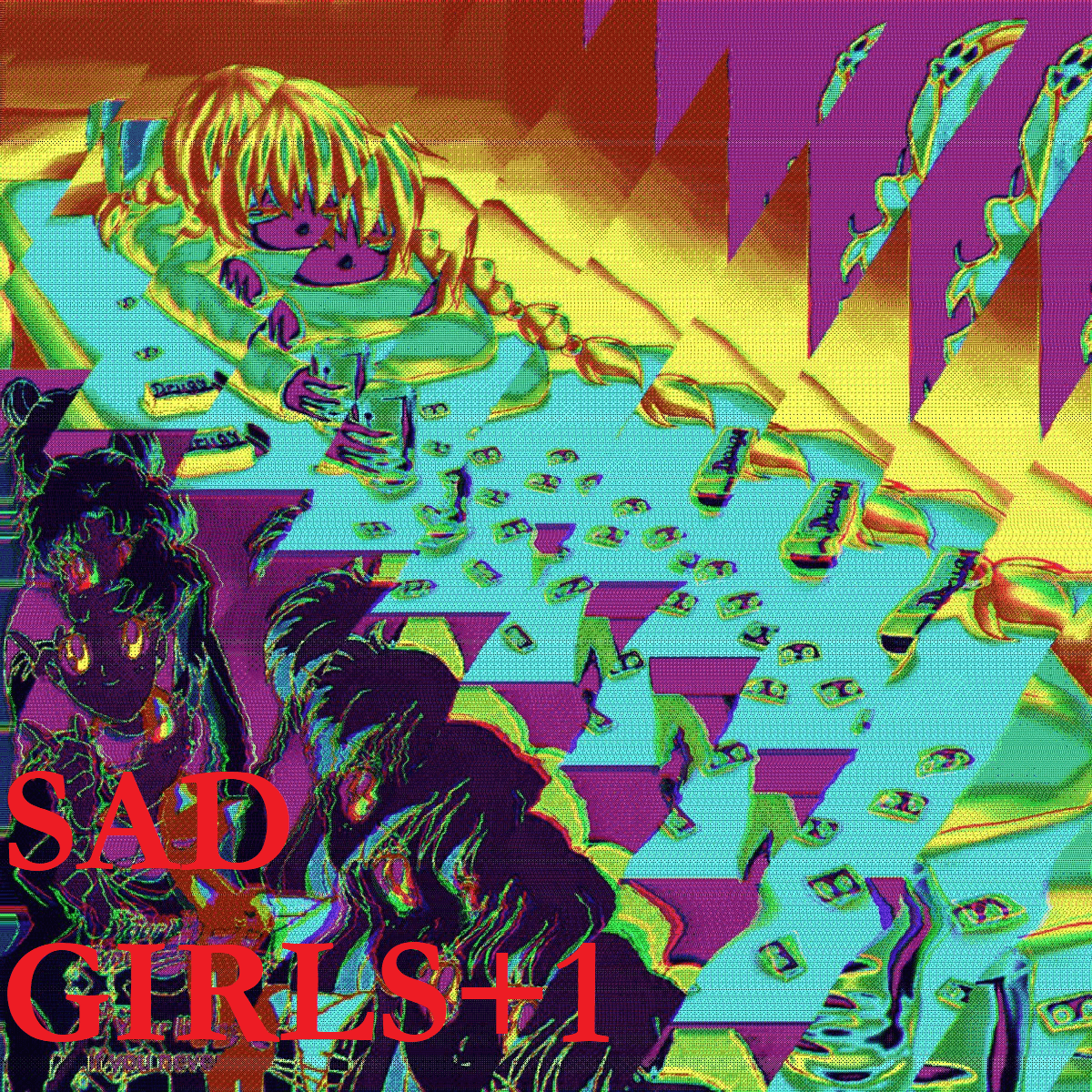
Content Warnings:
Abuse, Blood, Bodily Waste, Drugs, Lolicon, Pornography, Quoted Slurs, Self-Harm, Suicide.
She sits alone at her computer. The monitor glow highlights the bags under her eyes. Perhaps a cigarette hangs from her mouth. If there’s alcohol, it must be vodka, drunk straight from the bottle. If not, maybe cans of Monster Zero can litter the apartment. She wears a loose-fitting sweater, perhaps off-the-shoulder: a skirt and striped knee socks. Candy coloured pills of comical size lay on the desk in front of her. What are they for? It does not matter. The room is messy but not unclean. An AR-15 style rifle slung from the door handle. Her hair is unkempt but in curated way. Her bangs cast shadows across her pale face.
She is the Sad Girl. And she is Legion- at least, in the two-dimensional world. Perhaps you have seen her. On a Twitter account with relatable captions. A side character in a late-night anime. Innumerable RPG-Maker games and Visual Novels. Or- one shudders to think- as the avatar of a horrible opinion haver, an esoteric nationalist or indeed, someone very sad. Her face sloughed off into a multipurpose mask, she continues to spread, no longer a character, but an-
AVATAR OF SUFFERING
The purest archetype of the online sad girl is Lain, the main character of the cult cyberpunk anime Serial Experiments Lain. While not a substance abuser (mostly), she has the bedhead, the plain clothes, and the phosphor glow of CRTs practically bathe her. Then there is the sadness, of course. The series starts with her only friend in the world committing suicide. This tragedy is the catalyst for her becoming extremely online- unlike some later versions of sad_girl.exe; she is not “one of the nerds” from the get-go. While the “sad girl” is seldom sexualised (at least in comparison to other anime archetypes), Lain is not in herself a sexless doll, and indeed her being allowed to express herself beyond a monotype of suffering is vital to the series.
With that being the case, why is Lain the archetype? Why not Rei Ayanami, a character famously “not a doll,” yet more doll-like in each iteration? Why not Tomoko Kuroki, a character whose manga received an English release almost directly from 4chan interest? Because Lain, in and out of the setting, is a character of the internet. Though created before the mass adoption of broadband, she had an internet self separate from her own. “The Wired” dominates Lain’s world, with masses of buzzing cables delivering strange virtual worlds, worlds in which you can become anyone- worlds in which God itself may inhabit. Naturally, when imageboards rose in popularity, she was a prime subject for transmission. Her in-universe internet/wired persona was already a flattening and exaggeration of her character, one that would behave in ways her meatspace self would never consider. Her real-world internet self is then a copy of a copy, a pure symbol of NEETdom and despair. She adorns one of the hundreds of banners on 4chan, a 300x100 gif depicting her (what else?) staring into a glowing monitor. She shares company with other sad girl standards: the aforementioned Tomoko of Watamote, Misaki of Welcome to the N.H.K, and Madotsuki of Yume Nikki. All characters with inner lives, development and relationships rendered static in single moments of pain.
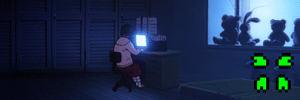
Well. Madotsuki is a particular case. If you wondered how a silent protagonist of an RPG-maker game could have her character simplified, look no further than her 4chan nickname: “Vomit-Chan”. A reference to a series of images created by guro artist Aosora (I will not link anything in this sentence) portraying her taking pills and struggling to hold in her puke with her hands. Like Yotsuba before her (4-leaf or even simply 4chan girl), she has been so stripped of context that she is denied her true name. A true avatar of suffering. I and many others praise the internet for facilitating remix culture, but it also melts down creations into base components, tokens intended to be skimmed over while scrolling. Given how abstract Yume Nikki is, perhaps that is inevitable. Madotsuki is staring at me as I write this, in plush form. Her sleepy face is a decent facsimile of her sprite, but as a plush it’s reconfigured into something cutesier. But a character needn’t be so malleable to become a sad girl.
When the formula is so pure, anything and anyone can be made to fit it.
HOW THE SAD SAUSAGE IS MADE
There just aren’t enough Lains in the world, so happy-go-lucky characters must also be processed to prevent a shortage. Usagi Tsukino of Sailor Moon is at most a bit of a crybaby when she’s not saving the world. Yet if you see her online, it’s often appended with fake sad quotes, VHS filters and chromatic aberration. This trend is not unique to anime, with episodes of The Simpsons chopped and screwed into depressing “Simpsonswave” videos. Aesthetic similarities aside, the narratives of these videos can only hope to tinge certain scenes with melancholy. They cannot define the Simpsons themselves. Perhaps that’s why the trend has come and gone, replaced with ever more esoteric ephemera, an alternate Simpsons universe to plug oneself into, ignoring the rotting corpse of the show itself. But the sad girl remains. Any edits of The Simpsons are directly riffing on one of the most well-known and successful pop-culture franchises. They are distinct from the original but impossible to consider without the said original. The relative inaccessibility and obscurity of even Sailor Moon mean for many people, fake sad girl Usagi is the Usagi they know.
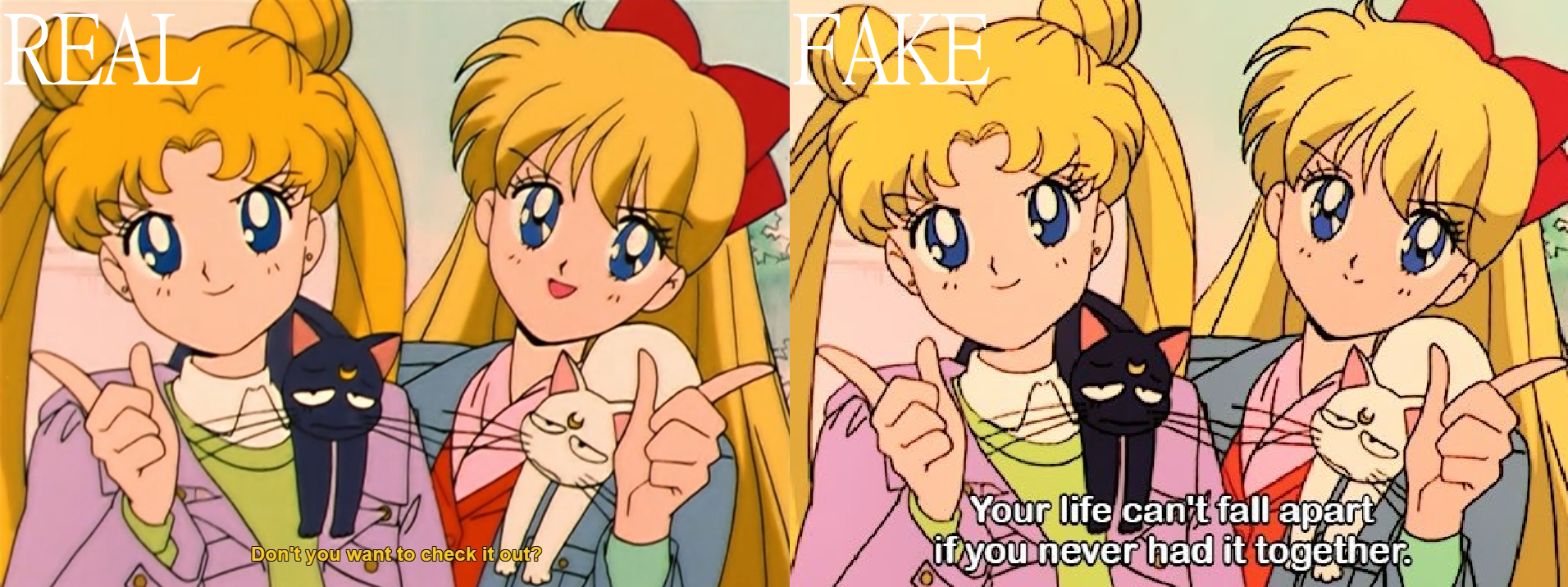
The alternative exists as reality, going as far as attributing counterfeit quotes to Naoko Takeuchi, the creator of the original manga. “I was at a low place, so I wrote about girls I wished were my friends” is the most common of these misquotes, going viral now and then thanks to being attached to low effort engagement farming tweets. It’s not enough for her to be one of the most talented and influential mangaka, her most famous work must be the product of the same malaise and loneliness that keeps certain sets of us on social media in the first place. Is it to indirectly sell the fantasy that art necessitates suffering, so your suffering may one day be worthwhile? Is it veiled misogyny, projecting insecurity onto a female creator rarely applied to a male one? I don’t think it’s fair to assume that of those that engage with this quote, but I do have to wonder about the intentions of its actual author. Hanlon’s razor suggests that we should “never attribute to malice that which is adequately explained by stupidity”, so I will be charitable and assume it was a misattribution that got out of hand. Hopefully, there will always be someone to try and correct the narrative, but there will always be more who share uncritically; allow this false factoid to stick in their brain, a consciousness Katamari rolling through the internet. Sailor Moon misrepresentation may only be directly harmful to Takeuchi’s reputation, but this same process can have far more sinister effects.
SOCK GIRLS
Chiaki J. Konaka, head writer on Digmon Tamers, managed to get himself in hot water by having the cast perform a bizarre play in which they fight the embodiment of “political correctness” attacking with “cancel culture” at its 20th anniversary. I don’t feel like I need to explain why having your children’s show characters enact your version of Ben Garrison comic is stupid. Considering he also wrote Serial Experiments Lain, I guess we’re lucky to have been spared a revival where Lain rails against the deep state. Still, I’m not interested in Konaka’s politics; if I had to have media align precisely with my political stance, there wouldn’t be much left. No, what’s interesting is that all these dumb opinions and conspiracy theories were already floating on his blog, but these only got attention after the Digifes 2021 performance. It was only by using his characters as sock puppets that any of his views got attention. This isn’t a unique phenomenon, nor is it limited to authors- after all, they’re supposed to be dead. Thus we have one of social media’s most infamous characters: the Anime Avi.
I like anime a bit, or at least enough to write a dissertation on Evangelion and have a 4TB external hard drive full of very legally acquired and officially translated TV series and OVAs. I have had an anime avatar on various sites over the years, and the current one (commissioned art of a short story character that will see the light of day soon™) is only a few steps removed. But merely having an anime avatar is not enough to be an Anime Avi. You need:
- A needlessly combative persona
- To have “Radical” opinions a hair’s breadth away from a Johnny Rebel song
- Be anti-censorship, unless it’s based
- To describe yourself as a classical liberal with “interesting opinions” on consent laws
- A subscription to an esoteric form of Christianity that still allows you to be relentlessly horny
- An inability to enjoy anything without worrying about it being too Reddit
Only with these combined with the anime girl avatar can form the true archetype. But it is still almost always a girl.
Regrettably, we need to go back to 2014. These types have existed for far longer than that, but anyone Extremely Online at that time may have already guessed where I’m going with this. Hell, its name is infamous enough that I’m sure my mother has glanced over it in a Telegraph article. GamerGate, the 4chan born harassment campaign that was “actually about ethics in gaming journalism”, is an indelible mark in online culture, something I observed from within the maelstrom. I won’t relitigate all I said about my experience on 4chan and how it compares to the ecosystems of other websites, but I’m thankful it wasn’t something I had much interest in. I was a bit too busy playing video games to be obsessed with its journalism, but endless threads on Anita Sarkeesian and Zoe Quinn were almost unavoidable. It didn’t take long for the discussion of Gamergate to be banned from 4chan, a move that eventually sparked the creation of 8chan. Remaining on 4chan wasn’t great for my mental health, but at least I didn’t migrate to the incubator of Q-Anon. I did, unfortunately, bear witness to Vivian James.

The whys and hows of her creation are barely relevant, though I did end up discovering that there’s a Gamergate wiki while trying to refresh my memory, so check a sanity point off my character sheet. Long story short, 4chan was able to submit her as a character to the game Afterlife Empire by The Fine Young Capitalists, a TERF-adjacent production company that received thousands of dollars in anonymous donations to spite Zoe Quinn. Aside from a four-leaf clover in her hair and green and purple sweatshirt (a “very clever” reference to a memetic piece of Dragon Ball hentai), Vivian could be any store brand sad girl- though because it’s a product of /v/, or games in general, she’s pissed off, not sad. It didn’t take long for her to become the mascot of the movement as a whole. What better way to disprove your movement is a female harassment campaign than by inventing a woman to shield it?
(Yes, I know Andrew Dobson made the same point, broken clock etc.)
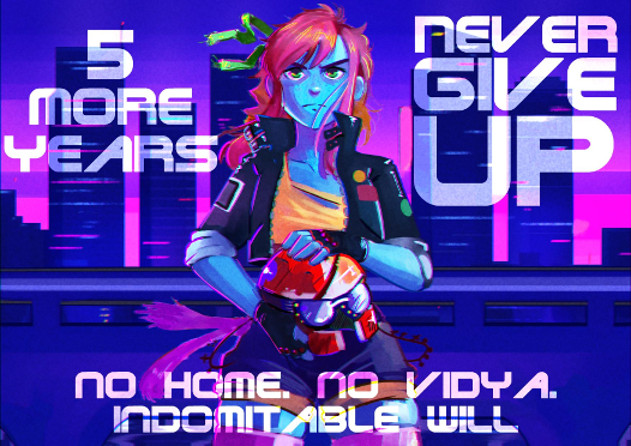
Gamergate may no longer be a thing, this extremely bleak anniversary image from 2019 being about the last attempt I can see to keep the torch lit. It doesn’t need to be a thing, of course, because as with every online movement, it will just forever splinter until one of those splinters jams into the right synapse of the collective consciousness, and we all have to acknowledge again, and if anyone doesn’t acknowledge it we’ll share it until they do. But.
Vivian James remains. She has survived the blastwave of online cultural rebirth, a golem animated by thousands and thousands of anonymous posters who continues to surface in the depths of online dreg heaps. An idea, no matter how rancid and reactionary, can defeat the marketplace if it is only anthropomorphised. I doubt words as dumb as “zoomer” and “soyface” would have stuck around without their crudely drawn wojack counterparts.
So, why is she a girl, then?
I WANT TO PROTECT THAT SMILE
It might surprise you to know, but the gestalt entity that is 4chan has some sexual hangups. Whether it’s complaining about Fatal Frame removing horny costumes for underaged characters, a general thread on Katawa Shoujo on its 3940th entry (and counting!) or its inability to separate “cute” from “I want to fuck it”- you don’t need to go far to find these kinds of posts, even on the blue “safe for work” boards. 4chan’s love of moe often plays into the sad girl trope, oscillating between “I can fix her” and “I want to rot alongside her”. As they infantilise women, they infantilise themselves, their English devolving into vaguely sinister baby-talk- “x is a cute!”, “I want to mating press y!” etc. The verbiage isn’t always so stomach churning, sometimes it’s more just depressing. The aforementioned Katawa Shoujo generals are particularly bleak, with their intense fetishism of anime disability requiring a disclaimer in the OP for people posting “I’m such a failure, I’ll never find my Katawa”- “While you may not physically be able to date Emi or any other Katawas, girls like them exist and there’s no reason why you can’t find one” follows a raft of links to the likes of Samaritans and the Suicide Prevention Lifeline. I hope the anons who need help get it, but from my experience that’ll be limited until they can extricate themselves from that environment. While these generals have an infamous reputation, perhaps they’re preferable to the chaos and in-fighting of /a/ (anime/manga) and /v/ (videogames), where the attempt to contain the far-right on the /pol/ (politics) board has so obviously failed, even with sad girls. Even in the (thankfully cursorary) browsing I had to do while revising this article, I found an off topic thread on /v/ lamenting that “even cute shy nerdy girls use tinder” (paired with a popular Twitter artists work that I’m sure would prefer not to be mentioned here), which only took two replies for a poster to respond:

Of course, it’s anything LGBTQ related still causes the most tensions, a strange thing for a website with weekly “homolust” generals and an entire /lgbt/ board, but 4chan is nothing if not contradictory. I’m still not sure how we got from “I wish to be the little girl” to “You will never be a woman.”
But, wait. “Little” girl?
If this is starting to sound a bit much, I suggest you jump ship because there’s an elephant in the room that can no longer be ignored.
Before my time, 4chan had a loli board. If you don’t know what loli is, please do not Google it, but I find that unfortunately unlikely if you’ve got this far. It comes from the term “Lolita complex”, and therefore the novel Lolita, and is most often used to describe an anime style drawing of pubescent (or pre-pubescent) girl. I’m not here to argue against the “drawings don’t have rights” crowd. Nothing I could say to them would ever pull them free from their tangle of mental gymnastics. But even 4chan removed this board, and any such content should (in theory) be immediately removed and have the poster permanently banned. They can get around this much the way Japanese media often does by insisting the girl with a 12-year-old’s body type is a 1000-year-old dragon, but this still mercifully leaves any explicit material off the table.
Too late. The aesthetic of loli dominates 4chan and the sad girl at large. They’re always sad girls, after all, never sad women. An obsession with “purity” and a condescending desire for a helpless girl they can raise or even “fix” is not something found in western otaku alone, but 4chan managed to further codify it into the “daughterfu” and thus normalise its appearance in more mainstream media.
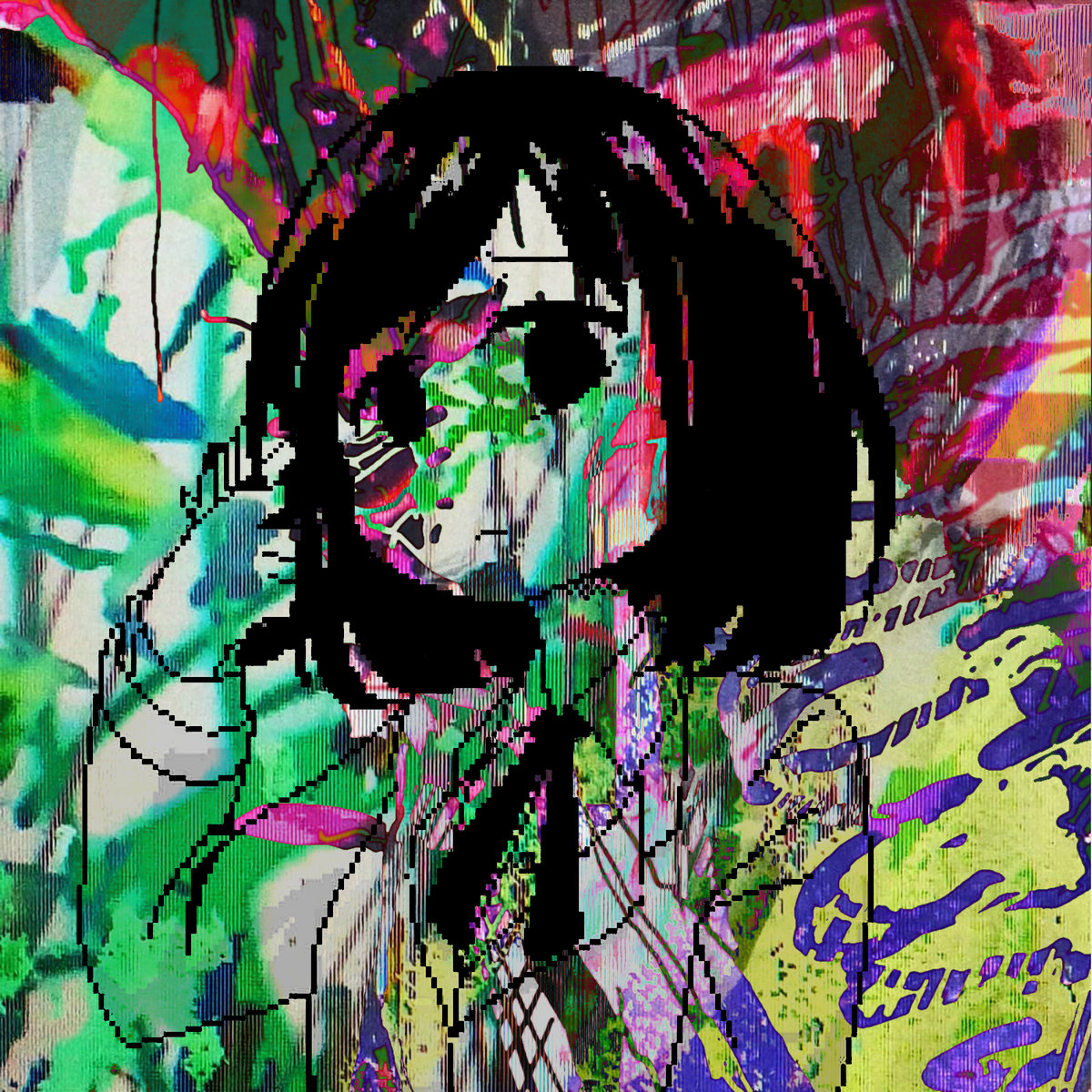
Electronic artist Sewerslvt’s “Mr Kill Myself” sits at 3.5 million views on YouTube, the art depicting a glitched-out schoolgirl with a gun to her head. It’s very much in the vein of lolicore, the genre of electronic music I encountered through goreshit and invented by LOLIRIPE. Sewerslvt’s music might not explicitly evoke loli with pitch-shifted vocals, but with project names like “Kawaii Razor Blades” and “Tortvred Lesbians Ripped Apart” paired with aesthetic filtered young girls, it swings back to defenceless, mentally ill avatars of suffering. I suspect their success lies not only with some admittedly catchy drum’n’bass riffs but also in filling that ever-present need for depressed nerds to cope by surrounding themselves with the aesthetic of suffering. This isn’t an own at their expense (it’d be a self-own anyway), but even in a world of mental health “acceptance”, it’s still challenging to open up to peers, let alone get professional help. So, there’s a market for selling sadness back to you, and Sewewslvt is far from the most egregious example, as irritating as “Skitzofrenia Simulation” is as a title.
The difficulty with critiquing this phenomenon is its prevalence in indie circles and to draw connections from loli pornography to these artists, game designers, and writers casts aspersions that I don’t believe are deserved. I don’t think the prevalence of this trope points to a prevalence in lolita complexes. Instead, the outsize influence sites like 4chan have had on nerd culture has let this aesthetic seep into the creative consciousness. Mainstream anime and video games haven’t helped this either. Kodomo no Jikan might be a (thankfully) distant memory, but Made in Abyss remains extremely popular. Hell, even Wikipedia deems it necessary to have an example image created especially for its page on the lolicon phenomena. It’s beyond normalised, at least on the internet, the same as self-deprecating sad posting. It’s pointless and probably unfair to criticise individuals for creating art that combines both when they may not be purposefully evoking either.
I wrestled with similar issues in my article “HORROR.COM”. The basic gist of it is simple: as horror has become more popular online, a lot of horror media intends less to scare and more to imitate and exaggerate that which has come before, leaving us with contextless wet meat puppets that are more the aesthetic of horror than the spirit of it. I was going to can the article because a) I shouldn’t decide what is and isn’t horror for people, and b) aside from justifiably dunking on Scott Cawthon and Fear Street, most of the article could be read as shitting on unnamed indie creators. That’s not the kind of energy I want to put out, and I guess the juries out if I managed to navigate that minefield. Likewise, if this article has to have a point, I would hope that it only sparks a bit of self-reflection in how and when we use this trope.
I know it did in me.
I, SAD GIRL
I revised this not as an attempt to recycle old Internet Content™ (mostly), but rather I wasn’t happy with all the conclusions I made. The biggest issues were in the beginning, where I originally asserted that sad girls are most often created and utilised by men, a claim I have no evidence for beyond the anecdotal, and one that’s easily challenged. I have unlisted the article from my archive since I’d prefer people find this version than that one, but you can still find it here if you’re interested in a shittier version. Other updates were more minor- some changes to reflect the passing of a year since the original (“HORROR.COM” wasn’t finished back then, there have been more KS generals), adding and clarifying examples, and typo-fixing. But then. The conclusion.
“I am, in a way, a sad girl. My internet moniker “S.T.” comes from a visual novel I attempted making in high school. S.T. may not have been a loli, but she was a NEET living alone in a neverending apartment complex. Like every idiot going into VN’s, having not read enough of them, I went for a subversion of tropes I barely understood. The player was tasked with attempting to foil an apocalyptic fate that was indeed impossible to thwart. By the end, S.T. would not be dead but mangled into a biomechanical horror with a bear-trap for a mouth. I won’t admonish myself for being an edgy teenager, but I didn’t leave this headspace altogether. The ongoing internal questioning of my gender does not adequately explain my majority-female protagonists suffering. I’ve accepted that I will always write edgy stuff, my Mothman serial aside, but it couldn’t hurt to be more even-handed than an 80s slasher movie. Even in my small, mostly private way, I have contributed to a trend I deemed worth criticism. If I am a sad girl, I should try not to contribute to the oversaturation of harmed and broken online females without good reason. If I am a sad boy, it shouldn’t be necessary to project my sadness onto a female character.”
Including the “S.T. origin story” was an attempt to balance my criticisms with some self-reflection, or if you want to be less charitable, a way to dodge accusations of hypocrisy. How well that works isn’t for me to decide, but a lot has changed since I wrote that. I suppose I have been more “even-handed”, with both my body horror shorts this year, even if the very binary logic of that whole paragraph makes me cringe to read now. FIN-DOM perhaps overcompensates for MEAT_SPACE’s female suffering, but in any case, it wasn’t intentional. The protagonist of FIN-DOM is male because that’s how I imagined him, the protagonist of MEAT_SPACE is female because… well, because I wrote it to work out some things about myself. It’s an unapologetically trans story that does not reflect everything about my experience but certainly helped me come to terms with who I am, and was even amusingly useful in coming out to my parents. I am a (sometimes) sad girl, who wrote a story about a sad girl. I’m not going to make any grand conclusions from that since it’s far too early to say, the process of transition is turbulent enough that I at least somewhat disagree with things I wrote a few months ago, never mind a year. I haven’t changed my mind that the “sad girl” as a phenomenon should be looked at critically, but overuse and problematic elements shouldn’t prevent people from contributing to this trend, especially when MEAT_SPACE was so cathartic. The original article ends like this:
“The Sad Girl is tired. She has been around for hundreds if not thousands of years, drowning in rivers as Ophelia and suffering in wideface as Madoka. Maybe it’s time for her to have a rest. Maybe she can smile instead.”
Well, maybe. I do believe we, the very online, could benefit from a more radical optimism. But the point should not be to deny comfort- even in the original, that was not my intention, flawed as it may have been presented. It’s that we should question what we find comfort in, and why we do.
Those questions are more useful than any conclusion I can give you. They helped me work out some things about who I am, who I want to be.
Maybe I won’t be alone in that.
..